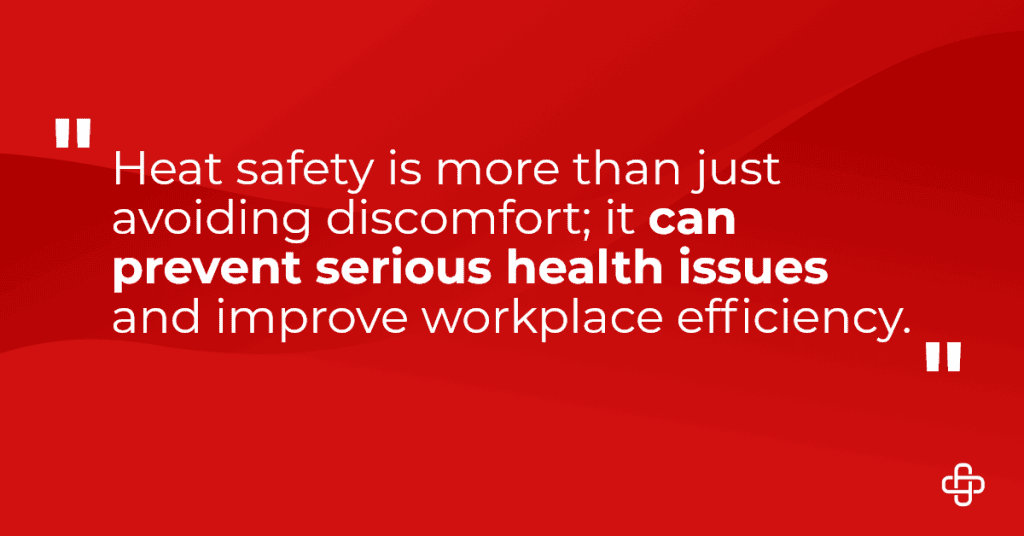Staying safe at work isn’t just about avoiding slips and falls. For employees and employers, recognizing the early signs of heat-related illness is crucial.
This guide will help you understand how to identify and prevent heat-related health issues, ensuring a safer and more productive workplace.

In this post, we’ll explore types of heat-related illnesses, their impact on work environments, early signs to watch for, preventative measures, and more.
By the end, you’ll have the knowledge to create a safer, healthier workspace for everyone.
Understanding the Types of Heat-Related Illnesses
Heat-related illnesses come in several forms. Understanding these can help you swiftly identify any problems.
1. Heat Exhaustion
Heat exhaustion occurs when the body loses too much water and salt through sweating.
Symptoms include heavy sweating, weakness, dizziness, nausea, and headaches. It’s often caused by intense physical activity in hot environments.
2. Heat Stroke
Heat stroke is the most severe heat-related illness. It happens when the body’s temperature rises above 104°F.
Symptoms include confusion, loss of consciousness, and seizures. Heat stroke is a medical emergency requiring immediate intervention.
3. Heat Cramps
Heat cramps are painful muscle spasms that occur due to dehydration and electrolyte imbalance. They usually affect the abdomen, arms, or legs.
4. Heat Rash
Heat rash appears as red clusters of pimples or small blisters. It is caused by excessive sweating and can occur on any part of the body.
While not life-threatening, it can be uncomfortable and lead to more severe skin infections if not treated.
The Impact of Heat-Related Illness on Work Environments
Heat-related illnesses don’t just affect individual health; they also impact the workplace.
Reduced Productivity
When employees are affected by heat-related illnesses, their productivity can significantly drop. They may struggle to focus, feel fatigued, and perform tasks slower than usual.
Safety Concerns
Heat can impair judgment and reaction times, increasing the risk of accidents and injuries. Workers may become more prone to mistakes, putting themselves and others in danger.
Employee Well-being
Chronic exposure to hot conditions can lead to long-term health problems, affecting overall employee well-being. This can result in increased absenteeism, turnover, and healthcare costs for the company.
Identifying Early Signs
Recognizing early signs of heat-related illnesses can prevent serious health issues.
Monitoring Physical Symptoms
Look for signs such as excessive sweating, skin that is pale or moist, dizziness, and muscle cramps. Early intervention can prevent these symptoms from escalating.
Behavioral Changes
Watch for unusual behavior like:
- irritability
- slurred speech
- confusion
- poor coordination
These could be early indicators of heat stress.
Prompt Action
If you notice any of these symptoms, act quickly. Move the person to a cooler area, encourage hydration, and seek medical attention if symptoms worsen.
Preventative Measures for Heat-Related Illness
Creating a safe work environment involves proactive measures.
- Hydration Strategies: Ensure employees have access to plenty of water. Encourage drinking small amounts regularly instead of waiting until they’re thirsty.
- Proper Clothing: Advise workers to wear lightweight, breathable clothing. Hats and sunglasses can also help protect against direct sun exposure.
- Work-Rest Schedules: Implement schedules that allow for regular breaks in cool, shaded areas. Adjust workloads and break times based on temperature and humidity levels.
Training and Education
Educating employees is key to preventing heat-related illnesses.
Risk Awareness
Make sure all employees understand the risks associated with working in hot conditions. Use training sessions and informational materials to spread awareness.
Emergency Response
Train staff on how to respond in case of a heat-related emergency. This includes recognizing symptoms, providing initial care, and contacting medical professionals.
Ongoing Education
Regularly update training materials and hold refresher courses. Stay informed about new safety recommendations and incorporate them into your training programs.
Axiom Medical’s Injury Case Management and Fatigue Assessments
Axiom Medical provides essential services like injury case management and fatigue assessments that play a critical role in proactively addressing heat-related illnesses at the first aid level.
By implementing comprehensive fatigue assessments, Axiom helps identify employees at risk of heat stress before symptoms escalate.
Their injury case management ensures that those showing early signs of heat-related illness receive timely interventions, including immediate first aid and appropriate monitoring.
This proactive approach not only facilitates quicker recovery but also enhances overall workplace safety by enabling management to adjust workloads and schedules in real-time.
By integrating these services, companies can create a more resilient workforce capable of handling heat-related challenges effectively.
Conclusion
Heat safety is more than just avoiding discomfort; it can prevent serious health issues and improve workplace efficiency.
By understanding the types of heat-related illnesses, recognizing early signs, and implementing preventative measures, you can create a safer, more productive environment for your team.
Ready to take the next step? Watch Axiom Medical’s webinar “Heat-Related Illness Prevention: Best Practices for Employers” and equip yourself with the knowledge to protect your workforce.
Prioritize heat safety—it’s an investment in your employees’ health and your company’s success.
Charli Pedersen is a published writer featured on Axiom Medical’s blog. She holds a bachelor’s degree in English, Professional and Technical Writing, and has experience creating content for businesses and non-profit organizations.










